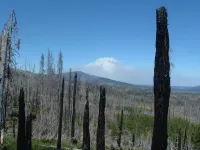(Press-News.org) CORVALLIS, Ore. - Human-caused wildfire ignitions in Central Oregon are expected to remain steady over the next four decades and lightning-caused ignitions are expected to decline, but the average size of a blaze from either cause is expected to rise, Oregon State University modeling suggests.
Scientists including Meg Krawchuk of the OSU College of Forestry and former OSU research associate Ana Barros, now of the Washington Department of Natural Resources, say the findings can help local decision-makers understand how a changing climate might affect natural and human-caused fire regimes differently and inform fire staffing, preparedness, prevention and restrictions.
"The significance of these results lies in what we can collectively do about it as a society and in our individual actions," Barros said. "For lightning-ignited fires, depending on where and when they happen, it can be an opportunity. Where safe for firefighters, communities and highly valued resources, we can use these ignitions to accomplish important forest restoration work."
Findings of the study, which involved 3.3 million hectares on the east slope of the Cascade Range, were published in Environmental Research Letters.
"In the United States, two-thirds of the area burned by wildfires is from fires started by lightning, but human-caused blazes make fire seasons longer and result in fires reaching areas where they wouldn't naturally occur," said Krawchuk, a fire ecologist who oversees the College of Forestry's Landscape Fire and Conservation Science lab group. "People are the primary cause of large fires in both the eastern and western U.S., and while climate is the primary driver of how much area burns, the human footprint is a close second."
Wildfire is casting an increasingly large shadow globally, including in the American West, as the climate continues to become warmer and drier. Eight of the 10 largest California wildfires on record have occurred in the last seven years, and in 2020, multiple huge fires tore through the west side of the Cascade Range in Oregon, consuming more than 1 million acres.
Barros notes that in the lower 48 U.S. states, 29 million people live where there is potential for extreme wildfire, including 12 million considered "socially vulnerable."
"Census tracts that are majority Black, Hispanic or Native American are associated with the greatest vulnerability to wildfire," she said. "That means climate change is expected to exacerbate social inequalities unless ecosystems and communities do a good job of adapting to a changing climate and more fires in an equitable way."
Barros, Krawchuk, OSU faculty research assistant Rachel Houtman and collaborators from the U.S. Forest Service and the University of California, Merced looked at ignition data for the study area from 1992 through 2015. There were more than 15,000 ignitions, most of which did not result in a big blaze. Just 400 of the ignitions ended up burning an area greater than 10 hectares, but those fires accounted for 99% of the area that burned.
Melding those data with multiple global climate projections, the scientists developed statistical models for when and where fires could potentially occur between 2031 and 2060, and how much area they would burn, for lightning- and human-caused ignitions. The models included predictions for the number of fires and the frequency of extreme wildfire events, or EWEs.
The models, which include a metric for daily fuel dryness known as energy release component or ERC, predicted no significant change in the number of human-caused fire ignitions and a 14% reduction in lightning-caused ignitions, with the number of lightning fires per season burning more than 10 hectares staying about the same.
But mean fire sizes were 31% larger for fires caused by humans and 22% bigger for fires caused by lightning; predicted increases in area burned were driven by increases in mean fire size resulting from more extreme wildfire events.
"All but one of the climate models we considered projected increased frequency of record-breaking events, with the largest future fires being about twice as big as those of the contemporary period," Barros said.
The scientists note that historically, lightning ignitions in Central Oregon have been more likely on days with moderate fuel dryness and less likely on days with higher ERC. That's possibly because in the region, lightning-caused fires tend to happen after light precipitation such as that from cold fronts that can cause ERC to drop.
"When it comes to human-caused fires, the key word is prevention because any ignition can become that record-breaking event," Barros said. "The takeaway here is that large fires are coming our way. What we do about it between now and then will determine our success in mitigating negative consequences and even accomplish positive outcomes."
Collaborating with Krawchuk and Barros were Michelle Day, Alan Ager and Haiganoush Preisler of the Forest Service and John Abatzoglou of the University of California, Merced.
"Extreme wildfires are increasingly becoming a reality in many parts of the world, but how we respond to these fires and how we prevent them depends on a lot on how they start," Day said. "In our study we showed that historical records for fire size will continue to be broken. And the timing of these fires will differ depending on cause, with more human-caused ignitions happening in late summer and fall."
INFORMATION:
The National Science Foundation and the U.S. Department of Agriculture supported this research.
Researchers at the National Eye Institute (NEI) have determined how certain short protein fragments, called peptides, can protect neuronal cells found in the light-sensing retina layer at the back of the eye. The peptides might someday be used to treat degenerative retinal diseases, such as age-related macular degeneration (AMD). The study published today in the Journal of Neurochemistry. NEI is part of the National Institutes of Health.
A team led by Patricia Becerra, Ph.D., chief of the NEI Section on Protein Structure and Function, had previously derived these peptides from a protein called pigment epithelium-derived ...
A study of young immigrant mothers who are survivors of sex trafficking found that the trauma affected how they parented: it made them overprotective parents in a world perceived to be unsafe, it fueled emotional withdrawal when struggling with stress and mental health symptoms, and was a barrier to building confidence as mothers. Yet, they coped with such challenges finding meaning in the birth of their child and through social support and faith.
Results of the community-based participatory research study by researchers at Columbia University ...
An alternate-day intermittent fasting schedule offered less fat-reducing benefits than a matched "traditional" diet that restricts daily energy intake, according to a new, 3-week randomized trial involving 36 participants. The study, which is one of the first to tease apart the effects of fasting and daily energy restriction in lean individuals, indicates that alternate-day fasting may offer no fasting-specific health or metabolic benefits over a standard daily diet. However, the authors caution that longer studies with larger groups are needed. Intermittent fasting, which involves cycling through voluntary fasting and non-fasting periods, has become one of the most popular approaches to losing weight. There ...
We've seen robots take to the air, dive beneath the waves and perform all sorts of maneuvers on land. Now, researchers at UC Santa Barbara and Georgia Institute of Technology are exploring a new frontier: the ground beneath our feet. Taking their cues from plants and animals that have evolved to navigate subterranean spaces, they've developed a fast, controllable soft robot that can burrow through sand. The technology not only enables new applications for fast, precise and minimally invasive movement underground, but also lays mechanical foundations for new types of robots.
"The biggest challenges with moving through the ground ...
In a study of more than 10,600 adult patients hospitalized with COVID-19, women had significantly lower odds than men of in-hospital mortality. They also had fewer admissions to the intensive care unit and less need for mechanical ventilation. Women also had significantly lower odds of major adverse events, including acute cardiac injury, acute kidney injury, and venous thromboembolism, according to an article in the peer-reviewed Journal of Women's Health. Click here to read the article now.
"This comprehensive analysis is the largest study to date that directly assesses the impact of sex on COVID-19 outcomes," ...
Boston - New study results indicate that different comorbid conditions affecting individuals diagnosed with COVID-19 may impact how long they continue to receive positive SARS-CoV-2 polymerase chain reaction (PCR) test results. Individuals diagnosed with COVID-19 who are aged 60+, have three or more chronic medical conditions, particularly diabetes, obesity, rheumatologic disease, or an organ transplant, have positive PCR tests for longer periods of time compared to younger individuals without these comorbidities. However, the data showed no significant difference in the duration of positive PCR tests results by the degree of immunocompromise or for individuals receiving chemotherapy or steroids ...
EAST LANSING, Mich. - The original Star Trek television series took place in a future when space is the final frontier, but humanity hasn't reached that point quite yet.
As researchers like Michigan State University entomologists Sarah Smith and Anthony Cognato are reminding us, there's still plenty to discover right here on Earth.
Working in Central and South America, the duo discovered more than three dozen species of ambrosia beetles -- beetles that eat ambrosia fungus -- previously unknown to science. Smith and Cognato described these new species on June 16 in the journal ZooKeys.
The Spartans also selected ...
Researchers from Skoltech and their colleagues from the UK have managed to create a stable giant vortex in interacting polariton condensates, addressing a known challenge in quantized fluid dynamics. The findings open possibilities in creating uniquely structured coherent light sources and exploring many-body physics under unique extreme conditions. The paper was published in the journal Nature Communications.
In fluid dynamics, a vortex is a region where a fluid revolves around a point (2D) or a line (3D); you've clearly seen one in your sink ...
Ikoma, Japan - Humans pride themselves on being able to multitask, especially under pressure. But it turns out that we aren't the only ones who are organized: researchers from Japan have discovered that plants balance genome maintenance with organ growth by organizing different responses to DNA damage.
In a study published in Science Advances, a research team led by Nara Institute of Science and Technology has revealed that plants use combined control of the plant hormones cytokinin and auxin to organize DNA damage responses while maintaining growth.
Plants are highly adaptable organisms that never stop growing, thanks largely to the functions carried out by their roots. Because of the essential role that roots play in plant growth, ...
A new study using cells, transgenic mouse models, and cultured human lung tissue provides evidence that the ability to trigger programmed cell death (apoptosis) may enable highly pathogenic coronaviruses to spread within their hosts so successfully. Targeting this process may reduce the severity of coronavirus diseases, the study goes on to show. While scientists have been aware that highly pathogenic coronaviruses leave substantial cell death in their wake as they infiltrate the body, the importance of apoptosis to the internal spread of coronavirus infections ...



